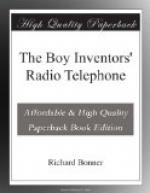“To use the old illustration, an electric impulse sent into the air spreads out in all directions just like the ripples from a stone chucked into a mill-pond,” said Jack.
“That’s it,” said Mr. Chadwick. “Now then, as you also know the wire telephone works by a metal disc in the receiver, vibrating in exactly the same way as does the microphone in the transmitter. According to the vibrations of the voice of the person sending the spoken message, the electric current along the wire, acted upon by the microphone in the transmitter, increases or decreases. This increasing and decreasing current acts on a thin metal disc or diaphragm in the receiver which is held to the ear of the person listening to the message.”
“That’s plain sailing so far,” said Jack. “For instance, when you say ‘Hullo’ over a phone, the microphone or transmitter gets busy and records it in electrical impulses and shoots it all along the wire where the receiver picks it up and wiggles the metal disc inside it to just the same tune.”
“That’s it exactly,” said Mr. Chadwick. “Now we are ready to go a step further. Now, as this metal disc is attracted or released by the current coming over the wire, it compresses or rarefies the air between it and the ear-drum of the person to whose oral cavity it is held. In this way the sensation of the same sound as was spoken at the transmitter end is reproduced at the receiver end. In other words, the transmitter jerks and jumps just as the needle of a phonograph does in traveling over a record, and transmits these jerks and jumps over the wire to the metal disc which by aerial pressure on the ear drums of the receiver of the message, causes the aural membrane to translate the words, or vibrations along the nerves, to the brain.
“Following up this line,” said Mr. Chadwick, “we find that the problem in radio telephony is the same as that met with in ordinary wire telephony. That is to say, we are required to cause a distant metal disc to repeat every inflection of the transmitter. But in the case of radio telephony the result is to be obtained by Hertzian waves, instead of by a current passing through an insulated wire.”
“The same sort of waves that are employed in wireless telegraphy?” asked Tom.
“Just the same, only in radio telephony we are confronted by a problem not met with in wireless telegraphy. We have not only to transmit sound, such as isolated dots and dashes, but to send through the air every rise and fall and inflection of the human voice just as it is recorded in the minute lines of a phonographic record.
“Experiments have shown that articulation, that is, understand, a speech, depends upon overtones and upper harmonies of a frequency of 5,000 or 8,000 or more.”
“What do you mean by frequency?” asked Tom.
“Speaking in reference to radio telephony it means the number of electrical vibrations per second required to produce a certain sound. In electric currents 100 per second is a low frequency current, 100,000 per second is spoken of as high frequency. In early experiments with radio telephony it was found that the chief difficulty lay in obtaining a current of sufficiently high frequency to transmit the human voice, the currents used in wireless telephony being much too weak for this purpose.




